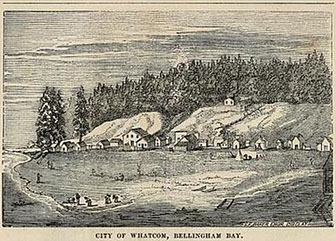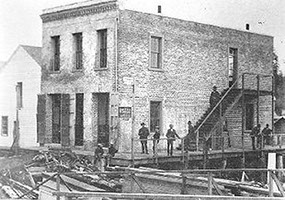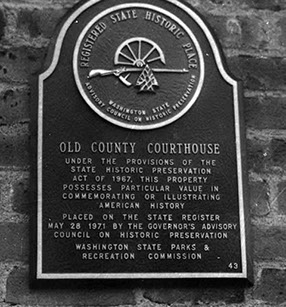Introduction
As the history of the Pacific Northwest moves into the 21st century, it seems clearer than ever that authentic fragments of material history from the mid-1800s are almost completely lost. Few buildings exist and fewer still remain with meaningful context.The T.G. Richards Building (today known as the Territorial County Courthouse) connects with a period of Indian wars, gold rushes and the unsettled marine boundary between Canada and the United States. It dates from before the Civil War, the arrival of the transcontinental railroad and the emergence of cities on Puget Sound. It was the first brick masonry building to be erected in Washington Territory and the oldest standing brick building in the State today.
Early Historical Recognition
The T.G. Richards Building was recognized as historic when the Historic American Building Survey documented it in 1934. Although the ground around it has been altered, its material integrity is substantially intact, and as an architectural narrative of the events it has participated in over 150 years, its story is clear and will continue to speak to current and future generations.The Boom Begins
 In 1857, the Hudson Bay Company shipped 800 ounces of gold to the San
Francisco mint, and once the word spread, an obsessive migration was
on. In the spring and summer of 1858, the frontier settlement of
Whatcom on Bellingham Bay experienced a frenzied surge in population
that came with the mania of a gold rush. Thousands of merchants and
gold seekers arrived, estimated at 23,000 by sea primarily from
California and 8,000 by land largely from the eastern Washington
Colville gold fields. They poured into the town of Whatcom on their way
to the gold fields along Canada's Fraser River.
In 1857, the Hudson Bay Company shipped 800 ounces of gold to the San
Francisco mint, and once the word spread, an obsessive migration was
on. In the spring and summer of 1858, the frontier settlement of
Whatcom on Bellingham Bay experienced a frenzied surge in population
that came with the mania of a gold rush. Thousands of merchants and
gold seekers arrived, estimated at 23,000 by sea primarily from
California and 8,000 by land largely from the eastern Washington
Colville gold fields. They poured into the town of Whatcom on their way
to the gold fields along Canada's Fraser River. Beginning at Whatcom, a trail was cut through the dense fir and cedar forests that thrived at the base of the rugged Fraser River canyon, and optimistic promoters billed the gateway town as "the next San Francisco."
Merchants were quick to take advantage of the miners' business, noting the fortunes that had been made by provisioners during the California gold rush of 1849. In fact, many of the prospectors rushing into Whatcom on their way to the Fraser gold fields were veterans of the California rush. Most of them were Americans or the opportunistic mix of nationalities that made up the Forty-Niners-Australians, Chinese and hard rock coal miners from England, Wales and central Europe.
The First Owners
Among the very first entrepreneurs to move from San Francisco Bay to Bellingham Bay was the partnership of Thomas G. Richards and Company, intent on establishing a commercial base at Whatcom. This organization consisted of Thomas G. and Charles E. Richards, brothers; and John G. Hyatt, all of San Francisco.Whatcom County tax rolls from 1857 record the Richards brothers as owners of property valued at $10,000, ($265,341 in 2013 dollars) a considerable fortune in territorial days. Thomas (known as T. G. Richards) apparently contributed a majority of the capital to the new business in Whatcom, although he never came north. His brother Charles (known as C.E. Richards) was the junior partner and manager of the store.
The Richards Brothers hired John Hyatt as a clerk and he also had a stake in the business as well. In the 1860 Whatcom census he reports having real and personal property worth $25,000.
Construction
The T.G. Richards brick warehouse was built on the tide flats at the foot of the hills overlooking Bellingham Bay, not far from and Whatcom County's first industrial enterprise, the pioneering Roeder-Peabody sawmill. On July 5, 1858 the deed selling "lot number twelve in block five... having a front on E and Centre Street" was recorded for a payment of $600 to Mr. Peabody.The Wood-Framed Building
About this time, the T.G. Richards & Co. also bought the middle plot of land between Centre and D streets, where they built a wood framed store building from which to sell goods while the brick structure was being constructed. It was at the wood framed building that John G. Hyatt became the town of Whatcom's second Postmaster, and "provided a hundred boxes, at private expense, for the accommodation of the public." He continued in this position until January 1, 1860. The Post Office was later transferred to the brick T.G. Richards Building, where it remained until January, 1873.First News Accounts of Construction
 The July 24, 1858 issue of The Northern Light newspaper published the
first account of the construction of the brick building. It was noted
that a load of bricks had arrived from San Francisco for the Richards
partnership, and that they "are clearing ground for the erection of a
two story brick store and banking house." The publisher of the
newspaper, William Bausman, had an excellent vantage point to observe
the progress of this task, as The Northern Light was headquartered
directly across the street from the new store.
The July 24, 1858 issue of The Northern Light newspaper published the
first account of the construction of the brick building. It was noted
that a load of bricks had arrived from San Francisco for the Richards
partnership, and that they "are clearing ground for the erection of a
two story brick store and banking house." The publisher of the
newspaper, William Bausman, had an excellent vantage point to observe
the progress of this task, as The Northern Light was headquartered
directly across the street from the new store. In the July 31, 1858 edition of the paper, it was reported that the "two story brick building of T.G. Richards & Co., commenced a week ago, is progressing finely. The walls have gone up some six or eight feet, and have received the joist for the first floor. The iron shutters and doors are on the ground, so that no delay will be occasioned in carrying the edifice forward to speedy completion."
On August 28, 1858, The Northern Light further recorded that the building was nearly finished - "The fine two story fire-proof brick building of T.G. Richards & Company on E Street is so far completed as to require only a few finishing touches to render it fit for occupancy, and will be inaugurated by the reception of a stock of groceries and provisions in a few days."
The ad which the company ran in that same issue read:
T.G. Richards & CompanyThese first accounts refer to the building as a "warehouse" and not altogether as a store. Richards and Hyatt continued the mercantile business in the wood framed building until lack of customers made it unprofitable to continue at two locations. Greater value during the gold rush was realized by providing secure port-side storage for goods headed to the gold fields and for the probable returning gold.
Having completed their new fire-proof
Brick Warehouse, are now prepared to carry on a
Storage and Commission Business.
Cash advances made on consignments and goods stored in our warehouse.
The Bricks
 The origin of the bricks for the building has intrigued historians for
decades. One often told story was that they came around the Horn from
Philadelphia on the bark Ann Parry and were brought to Bellingham Bay
on July 16, 1858.
The origin of the bricks for the building has intrigued historians for
decades. One often told story was that they came around the Horn from
Philadelphia on the bark Ann Parry and were brought to Bellingham Bay
on July 16, 1858. In 2006 while working on a Save Our History grant, a researcher discovered that the name of the bark was spelled wrong. Her true name was the Ann Parry (not Ann Perry as had been believed) with a remarkable history as a trader and whaler beginning in 1825. More astonishing, she arrived in San Francisco from Salem, MA on December 30, 1849, seven years before she brought the bricks. She stayed in San Francisco until November, 1858.
The Ann Parry was owned by Captain George Chase of San Francisco who owned many ships. His son-in-law, William B. Bourn, was an investment banker who may have invested in the Sehome Mine. When word of the gold rush on the Fraser River in present day Canada broke out, the Ann Parry was already in the area.
In June, group of shippers chartered her as part of their Pioneer Line. The Ann Parry left in the company of several other ships and steamers for Victoria and Bellingham Bay around June 25. She carried, according to a notice in the Alta California's Shipping Intelligence, 100,000 bricks and 73 barrels of lime. But who made the bricks?
Solving a History Mystery
 While students studied the bricks during the 2006 Save Our History
project, a brick sample was sent to Dan Mosier, a geologist and
historian in San Francisco (click here to visit his Website).
He was knowledgeable about early brick makers in the town. Initial
study pointed to Nagel, one of the most famous brick makers in the
area, but it wasn't until 2008 that scientific analysis was able to
match the brick to known clay pits in San Francisco.
While students studied the bricks during the 2006 Save Our History
project, a brick sample was sent to Dan Mosier, a geologist and
historian in San Francisco (click here to visit his Website).
He was knowledgeable about early brick makers in the town. Initial
study pointed to Nagel, one of the most famous brick makers in the
area, but it wasn't until 2008 that scientific analysis was able to
match the brick to known clay pits in San Francisco. A few years later Mosier gave the Whatcom County Historical Society a chance to test a real Nagel brick fragment. The courthouse brick was a 97% match. Having a building made from Nagel brick is significant. Fort Point, an important military installation on San Francisco Bay, is made from Nagel bricks.
The entire building is said to have cost the company $8000 in gold to construct. Its sturdy brick form was the first masonry building constructed on Puget Sound and a distinct symbol of permanence amid the hasty wooden gold rush town of Whatcom before the Civil War.
Bust on Bellingham Bay
Unfortunately the 1858 boom in Whatcom ended almost as soon as it had begun. The bust came when British Columbia Governor Sir James Douglas decreed that all miners headed to the Fraser River must stop in Victoria on Vancouver Island and pay for a permit before being allowed into the Canadian gold fields. This left Whatcom out of the path to the gold fields, and the stream of gold seekers quickly faded away.In the words of Northern Light newspaper editor William Bausman as he left for San Francisco in the fall of 1858, "Whatcom has gone in, and the (Northern) Light has gone out" and "Nearly all the best buildings were taken down and carried to Victoria, leaving the two story brick, built by Richards and Hyatt, standing as the solitary monument of departed grandeur." During the boom times, lots were expensive and hard to obtain; after the miners faded away, it is said the owners had problems even giving them away!
The Richards/Hyatt Years: 1858-1863
C.E. Richards and John G. Hyatt continued business in the building until 1861. There were many transactions recorded during this time, dealing with selling fractions of shares of ownership in the building and business back and forth. The tangle of confusing transactions suggests that given the shortage of gold and currency, property shares became the daily barter among the residents of Whatcom. As an example, on January 12, 1859, Charles sold to John "one half part of the one-third part of the lot and buildings" for the sum of $1000.During this time, Richards and Hyatt both married Native American women from the local tribes. Charles wed a Nooksack woman named Annie, and fathered one, if not two children. John married Emma, a Lummi woman, and fathered a son, John G. Hyatt Jr. Both men and their families lived on the upper floors of the warehouse, with blankets dividing the space for each family.
C.E. Richards was the majority owner in 1861 when the partnership seems to have dissolved, with John Hyatt selling his share of the building to Richards for $2000 and his share of the merchandise inside of it for $3000. Richards continued the store operation.
In May 1863, the County issued warrants worth $2,000 to C.E. Richards as payment for the brick building. Richards in turn sold them for 20 to 40 cents on the dollar. An August 28, 1863 diary of the Sheriff James Kavanaugh records that on this date, C.E. Richards has sold the remains of everything in the store.
The January 18, 1864 New York Times reported the arrival of passengers C.E. Richards and John G. Hyatt from the steamship Ariel, which had departed earlier in the month from Panama. They did not return to Bellingham Bay.
The Courthouse Years: 1863-1888
On May 6, 1863, with the Civil War raging in the east, the county government purchased the brick building for use as a courthouse. Prior to the purchase, the first and second courthouses had been log buildings considered shabby and undignified even in their day. The move gave Whatcom County the first brick courthouse in Washington Territory.During its years of service as the seat of county government, the T.G. Richards Building provided offices for the county treasurer and assessor as well as serving as the county jail. Henry Roeder, Edward Eldridge, and many other founders of the community frequented the building. Roth's History of Whatcom County lists many officials who held positions with the county government and who would have occupied offices in the courthouse.
More than a Courthouse
 The courthouse had several functions.It was a polling place when
elections were held, and a perusal of the pages of Roth's book reveals
many heated political campaigns and discussions. The building also
sheltered commercial interests, one being a drug store run by Dr. A.W.
Thornton. The Bellingham Bay Mail, begun in 1873 by James Powers, was
published in a corner of the building. In a later interview, Powers
recalled that "I would work an occasional prisoner on the press."
The courthouse had several functions.It was a polling place when
elections were held, and a perusal of the pages of Roth's book reveals
many heated political campaigns and discussions. The building also
sheltered commercial interests, one being a drug store run by Dr. A.W.
Thornton. The Bellingham Bay Mail, begun in 1873 by James Powers, was
published in a corner of the building. In a later interview, Powers
recalled that "I would work an occasional prisoner on the press." The Courthouse Jail - 1863 to 1879
The jail was located on the bottom floor, and had held such local scalawags as Fairhaven founder "Dirty Dan" Harris, imprisoned for killing a man in a brawl. It appears that in 1875, the building underwent some repairs, and the floors were then partitioned into various offices. In February of 1877, repairs were made to the lower floor, and in January 1879, the county commissioners decided to build a separate jail to alleviate overcrowding in the brick building.Replaced by an Opera House - 1888-1890
About 1888, the building was pronounced unsafe for further county business, and governmental offices were moved to Purdy's Opera House, bringing to an end a quarter of a century's use of the brick building as the Whatcom County seat. A new courthouse at G and Ellsworth streets was finished in 1890.Two Stories Become One
 In 1906, the tide flats area surrounding the building was partially
filled in and the streets running up the hill were graded to a regular
incline. The grade change brought the level of E Street up to the
second floor of the building. A new entry was configured out of the far
left upper window.
In 1906, the tide flats area surrounding the building was partially
filled in and the streets running up the hill were graded to a regular
incline. The grade change brought the level of E Street up to the
second floor of the building. A new entry was configured out of the far
left upper window. When the project was finished, the windows that once occupied the original ground floor, were now barely seen peeking out at sidewalk level. Access to the former first floor was provided through the back doorway. A pitched gable roof was also framed in timber over the original flat roof.
Organizations that Used the Building: 1895-1955
 The brick building stood mostly vacant until about 1895 when it was
leased (purchased in 1903) to the Grand Army of the Republic (G.A.R.),
a Civil War veterans organization that also included the Women's
Auxiliary (W.R.C.). Its members included such illustrious citizens as
J.J. Edens and Ellery Rogers, and included veterans from many different
northern states.
The brick building stood mostly vacant until about 1895 when it was
leased (purchased in 1903) to the Grand Army of the Republic (G.A.R.),
a Civil War veterans organization that also included the Women's
Auxiliary (W.R.C.). Its members included such illustrious citizens as
J.J. Edens and Ellery Rogers, and included veterans from many different
northern states. By that time, the building was already recognized for its historical associations to the territorial era, Washington having become a State in 1889, and was seen as an appropriate home for the fraternal organization. For the next 30 years, the little hall housed the memories of Civil War soldiers growing older, telling and retelling their stories of war and glory until there were too few to meet.
The James B. Steadman Post #24 of the Grand Army of the Republic occupied the building until 1922, when it was sold to Jasper M. Riddle, a local road and sidewalk construction contractor. Many sidewalks in Bellingham still bear his name etched into the concrete poured long ago. Mr. Riddle gave the building to a lodge named the "Junior Order of American Mechanics," whose members were not junior in age and had little to do with mechanics. The organization had its lodge meeting room in the upstairs (street level) floor, where Mr. Riddle's grandson Bill Brooks remembers it smelling like "cigar smoke and spittoons." The lower floor was used as a dining room for the occasional meal that followed the meetings.
In 1934, during the initial years of Depression-era federal employment programs, the Survey of Historic American Buildings selected the structure for documentation as an important historical place. It was the first building selected in the North Puget Sound region, and is enrolled with the survey number HABS WA-39-W-3.
Later, the Jehovah's Witness church held services in the building, and continued to use it through the 1940s and early 1950s.
The Akers Family Years: 1955-2000
 In 1955, an important step was made in the preservation and restoration
of the T. G. Richards Building/Old Territorial Courthouse. Carl and
Nickie Akers purchased the building from the church group and did some
early restoration.
In 1955, an important step was made in the preservation and restoration
of the T. G. Richards Building/Old Territorial Courthouse. Carl and
Nickie Akers purchased the building from the church group and did some
early restoration. Through the years the Akers Taxidermy shop was a familiar icon to Whatcom County sportsmen. By 1969 their business had outgrown the building and they moved to the School of Industries Building at 1303 Astor Street. The Akers rented the building out to a woodworking shop and several pottery studios.
The Vietnam War Era
In 1969, the counterculture newspaper, Northwest Passage, began publication in the building, beckoning back to time the Bellingham Bay Mail newspaper launched from the building in 1873. During the Vietnam war era, Bellingham was a terminal for the underground railroad assisting young men evading the draft by going to Canada. The newspaper and artists operating out of the building were directly involved in the anti-war effort and the address became associated with alternative political activities and counterculture enterprises.Historic Designation and Acquisition by WCHS
 Carl and Nickie Akers succeeded in listing the building with the
Washington State Historical Register in 1971. In 2000, the Akers family
expressed their intention to turn the building over to the public or
non-profit ownership, specifically the Whatcom County Historical
Society, so it could be restored and preserved.
Carl and Nickie Akers succeeded in listing the building with the
Washington State Historical Register in 1971. In 2000, the Akers family
expressed their intention to turn the building over to the public or
non-profit ownership, specifically the Whatcom County Historical
Society, so it could be restored and preserved. In 2001, a Territorial Courthouse task force was formed to develop recommendations for the eventual preservation of the building. In 2003, the T. G. Richards Building was listed on the National Register of Historic Places. In October of 2004, the building was gifted to the Whatcom County Historical Society and the long process of restoration of the historic landmark was about to begin.
The T.G. Richards Building Restoration: 2000-2015
 The building restoration started with a fund-raising campaign in 2003
after the building was formally given to the Whatcom County Historical
Society. The building was in poor condition with a leaking roof, tons
of debris in all areas, and a corner of the building was separating and
in danger of collapse.
The building restoration started with a fund-raising campaign in 2003
after the building was formally given to the Whatcom County Historical
Society. The building was in poor condition with a leaking roof, tons
of debris in all areas, and a corner of the building was separating and
in danger of collapse. Volunteers cleaned the building, and a personal loan from one Society member allowed the brickwork repairs to start. Local contractors also volunteered to make emergency repairs to the roof. In the following years through 2009, various organizations including the Whatcom County Council, and more contractors donated money and labor to rebuild and restore the building to drawings made by architects in the 1930s. A number of people gave thousands of dollars and hundreds of hours in volunteer time to complete the restoration. By 2010, the exterior of the building was completed, and in the fall of 2011, a party was given to celebrate the completion of the interior restoration of the building.
 By 2014, all work on the building was completed except the exterior
walkways and a wheelchair lift. In the winter months of 2015, two Eagle
Scout projects involved the construction of fencing around the front
half of the property, helping to enhance and protect the property.
By 2014, all work on the building was completed except the exterior
walkways and a wheelchair lift. In the winter months of 2015, two Eagle
Scout projects involved the construction of fencing around the front
half of the property, helping to enhance and protect the property.This restoration allowed the Society to start planning for public use and for education programs. In 2014, the Society joined with other historical groups to have tours for school classes, and other small group programs.
In December of 2015, following full completion of the restoration, the building was flooded due to heavy snow, high tides and a failed pump. The entire bottom floor had to be replaced. Books and other items in storage were destroyed. Recovering from this disaster was difficult for a small volunteer organization with a mortgage, insurance and maintenance costs to pay. In 2017, the board voted to sell the building to Rick Tremaine, who spearheaded the restoration effort and who is dedicated to its preservation as an historical treasure. Rick, in turn, has sold the building to Brad Parberry, who has undertaken a complete second renovation.
The Whatcom County Historical Society is grateful to all those who contributed to the original restoration effort and to those who are restoring it to even grander condition. Raising awareness of the building's historical significance was always the goal and that has been happily achieved and the building will begin yet another chapter in its long life.










